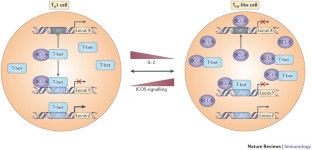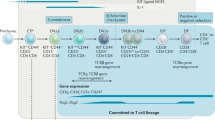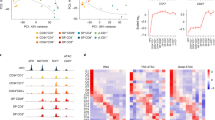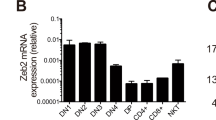Master regulators or lineage-specifying? Changing views on CD4 + T cell transcription factors
There is an emerging body of research demonstrating that the co-expression of key lineage-specifying transcription factors, commonly referred to as 'master regulators', affects the functional capabilities and flexibility of CD4 + T cell subsets. Here, we discuss how the natural co-expression of these lineage-specifying transcription factors has challenged the concept that the expression of a single 'master regulator' strictly establishes an absolute CD4 + T cell phenotype. Instead, it is becoming clear that the interplay between the lineage-specifying (or lineage-defining) transcription factors, including T-bet, GATA3, RORγt, BCL-6 and FOXP3, contributes to the fate and flexibility of CD4 + T cell subtypes. This in turn has led to the realization that CD4 + T cell phenotypes are more diverse than previously recognized.
This is a preview of subscription content, access via your institution
Access options
Subscribe to this journal
Receive 12 print issues and online access
206,07 € per year
only 17,17 € per issue
Buy this article
- Purchase on SpringerLink
- Instant access to full article PDF
Prices may be subject to local taxes which are calculated during checkout


Similar content being viewed by others

How transcription factors drive choice of the T cell fate
Article 11 September 2020

Distinct and temporary-restricted epigenetic mechanisms regulate human αβ and γδ T cell development
Article 27 July 2020

Zeb1 represses TCR signaling, promotes the proliferation of T cell progenitors and is essential for NK1.1 + T cell development
Article 12 May 2020
References
- Cedar, H. & Bergman, Y. Epigenetics of haematopoietic cell development. Nature Rev. Immunol.11, 478–488 (2011). ArticleCASGoogle Scholar
- Ho, L. & Crabtree, G. R. Chromatin remodelling during development. Nature463, 474–484 (2010). ArticleCASPubMedPubMed CentralGoogle Scholar
- Lessard, J. A. & Crabtree, G. R. Chromatin regulatory mechanisms in pluripotency. Annu. Rev. Cell Dev. Biol.26, 503–532 (2010). ArticleCASPubMedPubMed CentralGoogle Scholar
- Wilson, C. B., Rowell, E. & Sekimata, M. Epigenetic control of T-helper-cell differentiation. Nature Rev. Immunol.9, 91–105 (2009). ArticleCASGoogle Scholar
- Basso, K. & Dalla-Favera, R. BCL6: master regulator of the germinal center reaction and key oncogene in B cell lymphomagenesis. Adv. Immunol.105, 193–210 (2010). ArticleCASPubMedGoogle Scholar
- Kelly, K. F. & Daniel, J. M. POZ for effect – POZ-ZF transcription factors in cancer and development. Trends Cell Biol.16, 578–587 (2006). ArticleCASPubMedGoogle Scholar
- Lazarevic, V. & Glimcher, L. H. T-bet in disease. Nature Immunol.12, 597–606 (2011). ArticleCASGoogle Scholar
- Beaulieu, A. M. & Sant'Angelo, D. B. The BTB-ZF family of transcription factors: key regulators of lineage commitment and effector function development in the immune system. J. Immunol.187, 2841–2847 (2011). ArticleCASPubMedGoogle Scholar
- Szabo, S. J. et al. A novel transcription factor, T-bet, directs Th1 lineage commitment. Cell100, 655–669 (2000). ArticleCASPubMedGoogle Scholar
- Szabo, S. J. et al. Distinct effects of T-bet in TH1 lineage commitment and IFN-γ production in CD4 and CD8 T cells. Science295, 338–342 (2002). ArticleCASPubMedGoogle Scholar
- Haring, J. S., Badovinac, V. P., Olson, M. R., Varga, S. M. & Harty, J. T. In vivo generation of pathogen-specific Th1 cells in the absence of the IFN-γ receptor. J. Immunol.175, 3117–3122 (2005). ArticleCASPubMedGoogle Scholar
- Naiche, L. A., Harrelson, Z., Kelly, R. G. & Papaioannou, V. E. T-box genes in vertebrate development. Annu. Rev. Genet.39, 219–239 (2005). ArticleCASPubMedGoogle Scholar
- Fontenot, J. D., Gavin, M. A. & Rudensky, A. Y. Foxp3 programs the development and function of CD4 + CD25 + regulatory T cells. Nature Immunol.4, 330–336 (2003). ArticleCASGoogle Scholar
- Hori, S., Nomura, T. & Sakaguchi, S. Control of regulatory T cell development by the transcription factor Foxp3. Science299, 1057–1061 (2003). CASPubMedGoogle Scholar
- Ivanov, I. I. et al. The orphan nuclear receptor RORγt directs the differentiation program of proinflammatory IL-17 + T helper cells. Cell126, 1121–1133 (2006). ArticleCASPubMedGoogle Scholar
- Johnston, R. J. et al. Bcl6 and Blimp-1 are reciprocal and antagonistic regulators of T follicular helper cell differentiation. Science325, 1006–1010 (2009). ArticleCASPubMedPubMed CentralGoogle Scholar
- Nurieva, R. I. et al. Bcl6 mediates the development of T follicular helper cells. Science325, 1001–1005 (2009). ArticleCASPubMedPubMed CentralGoogle Scholar
- Yu, D. et al. The transcriptional repressor Bcl-6 directs T follicular helper cell lineage commitment. Immunity31, 457–468 (2009). ArticleCASPubMedGoogle Scholar
- Zheng, W. & Flavell, R. A. The transcription factor GATA-3 is necessary and sufficient for Th2 cytokine gene expression in CD4 T cells. Cell89, 587–596 (1997). ArticleCASPubMedGoogle Scholar
- Murphy, K. M. & Stockinger, B. Effector T cell plasticity: flexibility in the face of changing circumstances. Nature Immunol.11, 674–680 (2010). ArticleCASGoogle Scholar
- O'Shea, J. J. & Paul, W. E. Mechanisms underlying lineage commitment and plasticity of helper CD4 + T cells. Science327, 1098–1102 (2010). ArticleCASPubMedPubMed CentralGoogle Scholar
- Zhou, L., Chong, M. M. & Littman, D. R. Plasticity of CD4 + T cell lineage differentiation. Immunity30, 646–655 (2009). ArticleCASPubMedGoogle Scholar
- Chaudhry, A. et al. CD4 + regulatory T cells control TH17 responses in a Stat3-dependent manner. Science326, 986–991 (2009). ArticleCASPubMedPubMed CentralGoogle Scholar
- Chung, Y. et al. Follicular regulatory T cells expressing Foxp3 and Bcl-6 suppress germinal center reactions. Nature Med.17, 983–988 (2011). ArticleCASPubMedGoogle Scholar
- Hegazy, A. N. et al. Interferons direct Th2 cell reprogramming to generate a stable GATA-3 + T-bet + cell subset with combined Th2 and Th1 cell functions. Immunity32, 116–128 (2010). ArticleCASPubMedGoogle Scholar
- Hwang, E. S., Szabo, S. J., Schwartzberg, P. L. & Glimcher, L. H. T helper cell fate specified by kinase-mediated interaction of T-bet with GATA-3. Science307, 430–433 (2005). ArticleCASPubMedGoogle Scholar
- Koch, M. A. et al. The transcription factor T-bet controls regulatory T cell homeostasis and function during type 1 inflammation. Nature Immunol.10, 595–602 (2009). ArticleCASGoogle Scholar
- Linterman, M. A. et al. Foxp3 + follicular regulatory T cells control the germinal center response. Nature Med.17, 975–982 (2011). ArticleCASPubMedGoogle Scholar
- Oestreich, K. J., Huang, A. C. & Weinmann, A. S. The lineage-defining factors T-bet and Bcl-6 collaborate to regulate Th1 gene expression patterns. J. Exp. Med.208, 1001–1013 (2011). ArticleCASPubMedPubMed CentralGoogle Scholar
- Oestreich, K. J., Mohn, S. E. & Weinmann, A. S. Molecular mechanisms that control the expression and activity of Bcl-6 in TH1 cells to regulate flexibility with a TFH-like gene profile. Nature Immunol.13, 405–411 (2012). ArticleCASGoogle Scholar
- Oldenhove, G. et al. Decrease of Foxp3 + Treg cell number and acquisition of effector cell phenotype during lethal infection. Immunity31, 772–786 (2009). ArticleCASPubMedPubMed CentralGoogle Scholar
- Osorio, F. et al. DC activated via dectin-1 convert Treg into IL-17 producers. Eur. J. Immunol.38, 3274–3281 (2008). ArticleCASPubMedPubMed CentralGoogle Scholar
- Wang, Y., Su, M. A. & Wan, Y. Y. An essential role of the transcription factor GATA-3 for the function of regulatory T cells. Immunity35, 337–348 (2011). ArticleCASPubMedPubMed CentralGoogle Scholar
- Zhang, F., Meng, G. & Strober, W. Interactions among the transcription factors Runx1, RORγt and Foxp3 regulate the differentiation of interleukin 17-producing T cells. Nature Immunol.9, 1297–1306 (2008). ArticleCASGoogle Scholar
- Zhou, L. et al. TGF-β-induced Foxp3 inhibits TH17 cell differentiation by antagonizing RORγt function. Nature453, 236–240 (2008). ArticleCASPubMedPubMed CentralGoogle Scholar
- Ghoreschi, K. et al. Generation of pathogenic TH17 cells in the absence of TGF-β signalling. Nature467, 967–971 (2010). ArticleCASPubMedPubMed CentralGoogle Scholar
- Pepper, M., Pagan, A. J., Igyarto, B. Z., Taylor, J. J. & Jenkins, M. K. Opposing signals from the Bcl6 transcription factor and the interleukin-2 receptor generate T helper 1 central and effector memory cells. Immunity35, 583–595 (2011). ArticleCASPubMedPubMed CentralGoogle Scholar
- Nakayamada, S., Takahashi, H., Kanno, Y. & O'Shea, J. J. Helper T cell diversity and plasticity. Curr. Opin. Immunol.24, 297–302 (2012). ArticleCASPubMedPubMed CentralGoogle Scholar
- Campbell, D. J. & Koch, M. A. Phenotypical and functional specialization of FOXP3 + regulatory T cells. Nature Rev. Immunol.11, 119–130 (2011). ArticleCASGoogle Scholar
- Josefowicz, S. Z., Lu, L. F. & Rudensky, A. Y. Regulatory T cells: mechanisms of differentiation and function. Annu. Rev. Immunol.30, 531–564 (2012). ArticleCASPubMedPubMed CentralGoogle Scholar
- Rudra, D. et al. Transcription factor Foxp3 and its protein partners form a complex regulatory network. Nature Immunol.13, 1010–1019 (2012). ArticleCASGoogle Scholar
- Acosta-Rodriguez, E. V. et al. Surface phenotype and antigenic specificity of human interleukin 17-producing T helper memory cells. Nature Immunol.8, 639–646 (2007). ArticleCASGoogle Scholar
- Wilson, N. J. et al. Development, cytokine profile and function of human interleukin 17-producing helper T cells. Nature Immunol.8, 950–957 (2007). ArticleCASGoogle Scholar
- Zielinski, C. E. et al. Pathogen-induced human TH17 cells produce IFN-γ or IL-10 and are regulated by IL-1β. Nature484, 514–518 (2012). ArticleCASPubMedGoogle Scholar
- Lee, Y. et al. Induction and molecular signature of pathogenic TH17 cells. Nature Immunol.13, 991–999 (2012). ArticleCASGoogle Scholar
- Lu, K. T. et al. Functional and epigenetic studies reveal multistep differentiation and plasticity of in vitro-generated and in vivo-derived follicular T helper cells. Immunity35, 622–632 (2011). ArticleCASPubMedPubMed CentralGoogle Scholar
- Nakayamada, S. et al. Early Th1 cell differentiation is marked by a Tfh cell-like transition. Immunity35, 919–931 (2011). ArticleCASPubMedPubMed CentralGoogle Scholar
- Ballesteros-Tato, A. et al. Interleukin-2 inhibits germinal center formation by limiting T follicular helper cell differentiation. Immunity36, 847–856 (2012). ArticleCASPubMedPubMed CentralGoogle Scholar
- Johnston, R. J., Choi, Y. S., Diamond, J. A., Yang, J. A. & Crotty, S. STAT5 is a potent negative regulator of TFH cell differentiation. J. Exp. Med.209, 243–250 (2012). ArticleCASPubMedPubMed CentralGoogle Scholar
- Wei, G. et al. Global mapping of H3K4me3 and H3K27me3 reveals specificity and plasticity in lineage fate determination of differentiating CD4 + T cells. Immunity30, 155–167 (2009). ArticlePubMedPubMed CentralGoogle Scholar
- Oestreich, K. J. & Weinmann, A. S. T-bet employs diverse regulatory mechanisms to repress transcription. Trends Immunol.33, 78–83 (2012). ArticleCASPubMedGoogle Scholar
- Afkarian, M. et al. T-bet is a STAT1-induced regulator of IL-12R expression in naive CD4 + T cells. Nature Immunol.3, 549–557 (2002). ArticleCASGoogle Scholar
- Carter, L. L. & Murphy, K. M. Lineage-specific requirement for signal transducer and activator of transcription (Stat)4 in interferon γ production from CD4 + versus CD8 + T cells. J. Exp. Med.189, 1355–1360 (1999). ArticleCASPubMedPubMed CentralGoogle Scholar
- Kaplan, M. H., Sun, Y. L., Hoey, T. & Grusby, M. J. Impaired IL-12 responses and enhanced development of Th2 cells in Stat4-deficient mice. Nature382, 174–177 (1996). ArticleCASPubMedGoogle Scholar
- Lighvani, A. A. et al. T-bet is rapidly induced by interferon-γ in lymphoid and myeloid cells. Proc. Natl Acad. Sci. USA98, 15137–15142 (2001). ArticleCASPubMedPubMed CentralGoogle Scholar
- Nishikomori, R. et al. Activated STAT4 has an essential role in Th1 differentiation and proliferation that is independent of its role in the maintenance of IL-12Rβ2 chain expression and signaling. J. Immunol.169, 4388–4398 (2002). ArticleCASPubMedGoogle Scholar
- O'Shea, J. J., Lahesmaa, R., Vahedi, G., Laurence, A. & Kanno, Y. Genomic views of STAT function in CD4 + T helper cell differentiation. Nature Rev. Immunol.11, 239–250 (2011). ArticleCASGoogle Scholar
- Thierfelder, W. E. et al. Requirement for Stat4 in interleukin-12-mediated responses of natural killer and T cells. Nature382, 171–174 (1996). ArticleCASPubMedGoogle Scholar
- Usui, T., Nishikomori, R., Kitani, A. & Strober, W. GATA-3 suppresses Th1 development by downregulation of Stat4 and not through effects on IL-12Rβ2 chain or T-bet. Immunity18, 415–428 (2003). ArticleCASPubMedGoogle Scholar
- Aronica, M. A. et al. Preferential role for NF-κB/Rel signaling in the type 1 but not type 2 T cell-dependent immune response in vivo. J. Immunol.163, 5116–5124 (1999). CASPubMedGoogle Scholar
- Avni, O. et al. TH cell differentiation is accompanied by dynamic changes in histone acetylation of cytokine genes. Nature Immunol.3, 643–651 (2002). ArticleCASGoogle Scholar
- Grenningloh, R., Kang, B. Y. & Ho, I. C. Ets-1, a functional cofactor of T-bet, is essential for Th1 inflammatory responses. J. Exp. Med.201, 615–626 (2005). ArticleCASPubMedPubMed CentralGoogle Scholar
- Kiani, A. et al. Regulation of interferon-γ gene expression by nuclear factor of activated T cells. Blood98, 1480–1488 (2001). ArticleCASPubMedGoogle Scholar
- Miyazaki, M. et al. The opposing roles of the transcription factor E2A and its antagonist Id3 that orchestrate and enforce the naive fate of T cells. Nature Immunol.12, 992–1001 (2011). ArticleCASGoogle Scholar
- Bettini, M. L. et al. Loss of epigenetic modification driven by the Foxp3 transcription factor leads to regulatory T cell insufficiency. Immunity36, 717–730 (2012). ArticleCASPubMedPubMed CentralGoogle Scholar
- Darce, J. et al. An N-terminal mutation of the Foxp3 transcription factor alleviates arthritis but exacerbates diabetes. Immunity36, 731–741 (2012). ArticleCASPubMedPubMed CentralGoogle Scholar
Acknowledgements
We thank members of the Weinmann laboratory for lively discussions on this topic. The research in the authors' laboratory is supported by grants from the US National Institute of Allergy and Infectious Diseases (AI061061 and AI07272) and the American Cancer Society (RSG-09-045-01-DDC) to A.S.W.
Author information
Authors and Affiliations
- Kenneth J. Oestreich and Amy S. Weinmann are at the Department of Immunology, University of Washington, Box 357650, 1959 NE Pacific Street, Seattle, Washington 98195, USA., Kenneth J. Oestreich & Amy S. Weinmann
- Kenneth J. Oestreich






